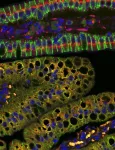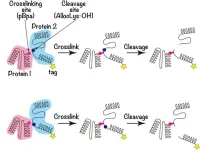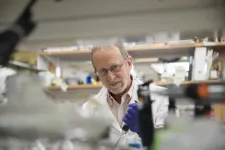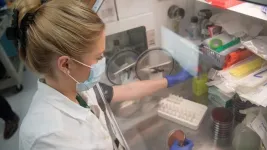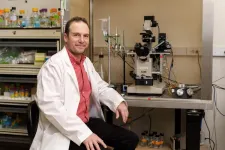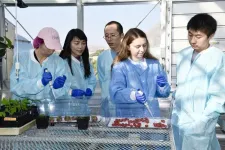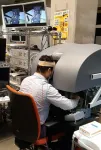(Press-News.org) Scientists have discovered one of the first new classes of antibiotics identified in the past 60 years, and the first discovered leveraging an AI-powered platform built around explainable deep learning.
Published in Nature today, the peer-reviewed paper, entitled “Discovery of a structural class of antibiotics with explainable deep learning,” was co-authored by a team of 21 researchers, led by Felix Wong, Ph.D., co-founder of Integrated Biosciences, and James J. Collins, Ph.D., Termeer Professor of Medical Engineering and Science at MIT and founding chair of the Integrated Biosciences Scientific Advisory Board.
Additional collaborators included researchers at the Massachusetts Institute of Technology (MIT), the Broad Institute of MIT and Harvard, the Wyss Institute for Biologically Inspired Engineering, and the Leibniz Institute of Polymer Research in Dresden, Germany. In their study, the researchers virtually screened more than 12 million candidate compounds to identify this new class of antibiotics, which show potential to address antibiotic resistance.
In this groundbreaking approach, the team of researchers trained deep learning models on experimentally generated data to predict the antibiotic activity and toxicity of any compound. Drawing inspiration from AI used in other contexts, including DeepMind’s AlphaGo gaming technology, the authors designed new models to explain which parts of a molecule were important for antibiotic activity.
The result was the identification of a new class of antibiotics with potent activity against multidrug-resistant pathogens. In one series of experiments, the researchers tested a candidate antibiotic in mouse models of MRSA infection and found that it was efficacious both topically and systemically, indicating that the compound could be suitable for further development as a treatment for severe and sepsis-related bacterial infections.
“This discovery of a new class of antibiotics is a breakthrough result showing that artificial intelligence and explainable deep learning are uniquely capable of catalyzing drug discovery,” said Dr. Wong. “Our work makes publicly available several high-powered models to accurately predict both antibiotic activity and toxicity. Importantly, this is one of the first demonstrations that deep learning models can explain what they are predicting, with immediate and far-reaching implications to how drug discovery is done and how efficiently we can find new drugs using AI.”
Dr. Collins said, “This is an important validation of how important the integration of AI and explainable deep learning will be to overcoming some of the most vexing challenges in medicine, in this case antibiotic resistance. Building on these validating studies and similar approaches, the Integrated Biosciences team is poised to further accelerate their integration of synthetic biology and a deep understanding of cellular stress to address a significant unmet need for new treatments targeting age-related diseases.”
Satotaka Omori, Ph.D., founding member and Head of Aging Biology at Integrated Biosciences, and a contributing author on the publication, said, “An important implication of this study is that deep learning models in drug discovery can, and in many cases should, be made explainable. While AI continues to make an impact, it is also limited by the many black box models that are commonly used and obfuscate the underlying decision-making process. By opening up these black boxes, we aim to create more generalizable insights that may be more useful in accelerating the use and development of next-generation approaches to drug discovery.”
Alicia Li, a research associate at Integrated Biosciences and a contributing author on the publication, added, “It’s really exciting to see how we’ve been able to demonstrate a new way to predict how useful a compound will be as an antibiotic, the likelihood that the compound will progress in Phase I trials, and whether or not the compound is one of potentially many other members in a novel class of drugs.”
Integrated Biosciences has built a body of research that, in addition to this new Nature publication, includes a Nature Aging paper published in May demonstrating how AI can be used to discover novel senolytics, anti-aging compounds that selectively eliminate senescent “zombie” cells. These compounds have shown promise in their ability to treat age-related diseases, such as fibrosis, inflammation, and cancer.
A Cell Systems paper published in July demonstrated a synthetic biology-based platform allowing human control over aging-associated stress responses, enabling accelerated drug screens for targeting aging.
The publication, “Discovery of a structural class of antibiotics with explainable deep learning,” can be accessed on the Nature website at: https://www.nature.com/articles/s41586-023-06887-8.
END
Catalyzing drug discovery with explainable deep learning
Researchers at MIT, the Broad Institute of MIT and Harvard, Integrated Biosciences, the Wyss Institute for Biologically Inspired Engineering, and the Leibniz Institute of Polymer Research have identified a new structural class of antibiotics.
2023-12-20
ELSE PRESS RELEASES FROM THIS DATE:
Study unveils a role of mitochondria in dietary fat processing
2023-12-20
The maintenance of a balanced lipid homeostasis is critical for our health. While consumption of excessive amounts of fatty foods contributes to metabolic diseases such as obesity and atherosclerosis, fat is an indispensable component of our diet. Digested lipids supply the body with essential building blocks and facilitate the absorption of important vitamins. In a new study published in the journal Nature, a team of researchers led by Professor Manolis Pasparakis and their collaborators Professor Aleksandra Trifunovic and Professor Christian Frezza at the Excellence Cluster CECAD of the University of Cologne, and Professor Jörg Heeren ...
Protein secrets unveiled: Newl molecular insight of protein–protein interactions
2023-12-20
Researchers from Tokyo Medical and Dental University (TMDU) have developed a new technique allowing the binding interfaces on two interacting proteins to be characterized, and validated it by describing the homophilic interaction between LAMP2A molecules
Tokyo, Japan – Proteins are building blocks of our bodies, but they do not work solo. They form partners to facilitate in different biological processes that keep us going. However, analyzing how proteins interact at a molecular level can be challenging. Now, a research team from Japan reveals the secrets behind these “protein partnerships”.
In a study published recently in Protein Science, researchers ...
Alzheimer’s discovery reveals dire effect of toxic tau protein on brain cells
2023-12-20
University of Virginia Alzheimer’s researchers have discovered how harmful tau proteins damage the essential operating instructions for our brain cells, a finding which could lead to new treatments.
The toxic protein, the researchers found, warps the shape of the nuclei of nerve cells, or neurons. This alters the function of genes contained inside and reprograms the cells to make more tau.
While the protein has long been a prime suspect in Alzheimer’s and other neurodegenerative “tauopathies,” the new research from UVA’s ...
Fraunhofer USA releases Annual Research Report, Focus 2023
2023-12-20
Fraunhofer USA, a leading nonprofit research organization dedicated to applied research and development services, is proud to announce the release of its Annual Report, Focus 2023. The report underscores Fraunhofer USA's commitment to fostering transatlantic collaboration, strengthening university-government partnerships, and driving impactful technology transfer.
Transatlantic Collaboration: A Pillar of Innovation
In the pursuit of global innovation, Fraunhofer USA continues to play a pivotal role in fostering transatlantic collaboration. The annual report highlights the organization's successful partnerships with Fraunhofer-Gesellschaft research institutes, resulting in groundbreaking ...
International collaboration to improve cancer care in Sub-Saharan Africa updates resources for sixth year
2023-12-20
PLYMOUTH MEETING, PA [December 20, 2023] — The National Comprehensive Cancer Network® (NCCN®)—an alliance of leading academic cancer centers in the United States—is celebrating six years of working alongside the African Cancer Coalition (ACC), the American Cancer Society (ACS), and the Clinton Health Access Initiative (CHAI), as part of Allied Against Cancer. The collaboration was formed to support and empower the Sub-Saharan African oncology community to advance health system capacity, ...
New study sheds light on the connection between the microbiome and kidney stones
2023-12-20
A new study from Lawson Health Research Institute and Western University published in the journal Microbiome has found changes in the microbiome in multiple locations in the body are linked to the formation of kidney stones.
The human microbiome comprises trillions of microorganisms, including healthy bacteria. In recent years, research has begun to uncover its role in health and numerous diseases.
The research team examined the gut, urinary and salivary microbiomes in 83 patients who had kidney stones ...
TTUHSC researcher studies the ability of brine shrimp to thrive in high salinity
2023-12-20
Brine shrimp of the genus Artemia are small crustaceans that can thrive in environments where sodium concentrations are as high as 25% (more than eight times typical ocean sea water). Also known by the household pet trademark ‘sea monkeys,’ these animals are abundant in inland salt lakes where brine-fly larvae are the only other animals known to exist.
The mechanisms which permit brine shrimp to tolerate some of the harshest environments are only partially understood. Previously known adaptive features include a tight protective layer (integument) to avoid water loss and the increased extrusion of sodium (Na+) and chloride (Cl-) ions ...
Digital training program improves quality of life for care residents with dementia – even during the COVID-19 pandemic
2023-12-20
Quality of life for people with dementia living in residential and nursing home care substantially improved after staff took part in a digital training programme that was specially adapted to Covid-19 restrictions. The training also led to a significant drop in the prescription of potentially harmful sedative medications to residents.
The iWHELD programme supported care home staff in delivering personalised care and encouraging meaningful social interactions. Through a digital platform featuring live coaching sessions led by trained coaches, the programme supported ...
Discovery: Plants use “trojan horse” to fight mold invasions
2023-12-20
UC Riverside scientists have discovered a stealth molecular weapon that plants use to attack the cells of invading gray mold.
If you’ve ever seen a fuzzy piece of fruit in your fridge, you’ve seen gray mold. It is an aggressive fungus that infects more than 1,400 different plant species: almost all fruits, vegetables, and many flowers. It is the second most damaging fungus for food crops in the world, causing billions in annual crop losses.
A new paper in the journal Cell Host & Microbe describes how plants send tiny, innocuous-seeming lipid “bubbles” filled with RNA across enemy lines, into the cells of the aggressive mold. Once ...
Could an electric nudge to the head help your doctor operate a surgical robot?
2023-12-20
People who received gentle electric currents on the back of their heads learned to maneuver a robotic surgery tool in virtual reality and then in a real setting much more easily than people who didn’t receive those nudges, a new study shows.
The findings offer the first glimpse of how stimulating a specific part of the brain called the cerebellum could help health care professionals take what they learn in virtual reality to real operating rooms, a much-needed transition in a field that increasingly relies on digital simulation training, said author and Johns Hopkins University roboticist Jeremy ...
LAST 30 PRESS RELEASES:
Making lighter work of calculating fluid and heat flow
Normalizing blood sugar can halve heart attack risk
Lowering blood sugar cuts heart attack risk in people with prediabetes
Study links genetic variants to risk of blinding eye disease in premature infants
Non-opioid ‘pain sponge’ therapy halts cartilage degeneration and relieves chronic pain
AI can pick up cultural values by mimicking how kids learn
China’s ecological redlines offer fast track to 30 x 30 global conservation goal
Invisible indoor threats: emerging household contaminants and their growing risks to human health
Adding antibody treatment to chemo boosts outcomes for children with rare cancer
Germline pathogenic variants among women without a history of breast cancer
Tanning beds triple melanoma risk, potentially causing broad DNA damage
Unique bond identified as key to viral infection speed
Indoor tanning makes youthful skin much older on a genetic level
Mouse model sheds new light on the causes and potential solutions to human GI problems linked to muscular dystrophy
The Journal of Nuclear Medicine ahead-of-print tip sheet: December 12, 2025
Smarter tools for peering into the microscopic world
Applications open for funding to conduct research in the Kinsey Institute archives
Global measure underestimates the severity of food insecurity
Child survivors of critical illness are missing out on timely follow up care
Risk-based vs annual breast cancer screening / the WISDOM randomized clinical trial
University of Toronto launches Electric Vehicle Innovation Ontario to accelerate advanced EV technologies and build Canada’s innovation advantage
Early relapse predicts poor outcomes in aggressive blood cancer
American College of Lifestyle Medicine applauds two CMS models aligned with lifestyle medicine practice and reimbursement
Clinical trial finds cannabis use not a barrier to quitting nicotine vaping
Supplemental nutrition assistance program policies and food insecurity
Switching immune cells to “night mode” could limit damage after a heart attack, study suggests
URI-based Global RIghts Project report spotlights continued troubling trends in worldwide inhumane treatment
Neutrophils are less aggressive at night, explaining why nighttime heart attacks cause less damage than daytime events
Menopausal hormone therapy may not pose breast cancer risk for women with BRCA mutations
Mobile health tool may improve quality of life for adolescent and young adult breast cancer survivors
[Press-News.org] Catalyzing drug discovery with explainable deep learningResearchers at MIT, the Broad Institute of MIT and Harvard, Integrated Biosciences, the Wyss Institute for Biologically Inspired Engineering, and the Leibniz Institute of Polymer Research have identified a new structural class of antibiotics.
